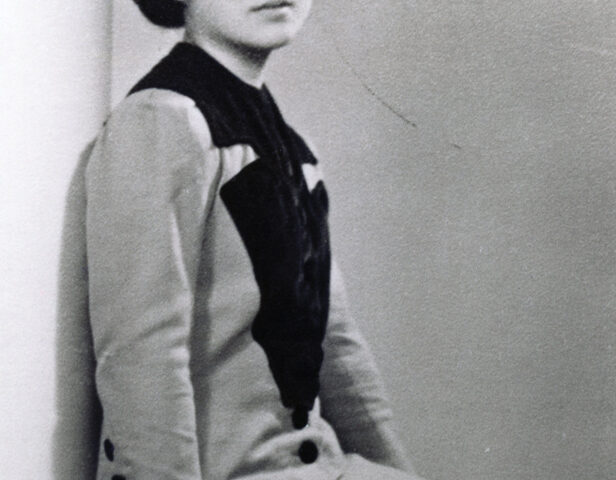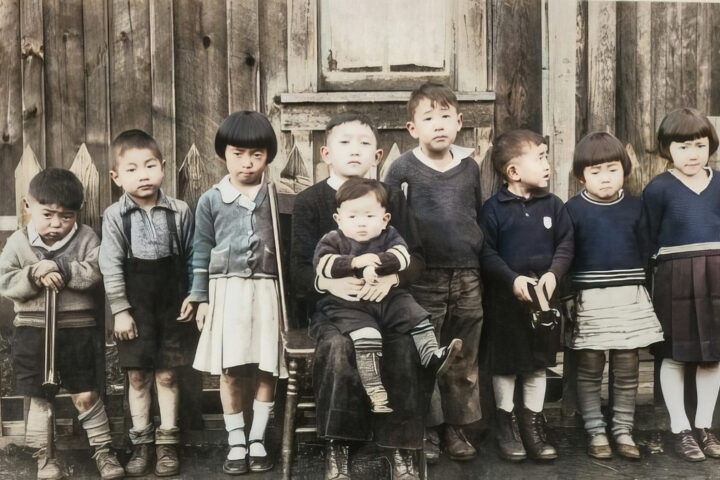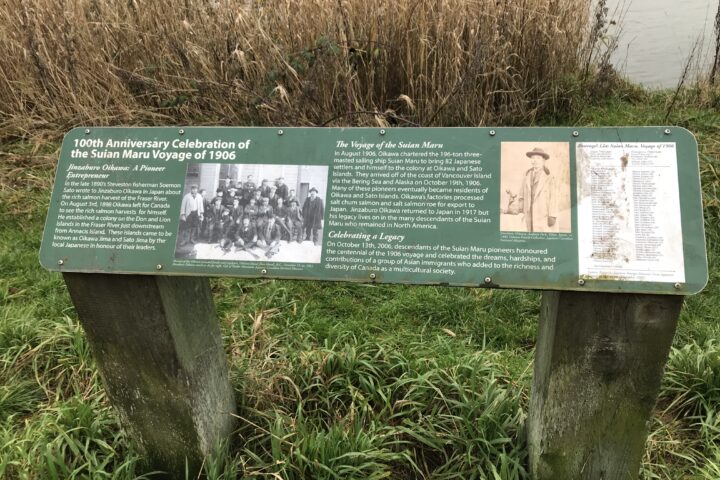In 2024, the National Association of Japanese Canadians (NAJC) is looking at geographic locations where Japanese Canadians lived after migrating to Canada, since the 1800s, and where they were interned/incarcerated in 1942. We respectfully acknowledge the ancestral and unceded territories of Indigenous peoples who are the traditional keepers of the lands and waters.
The Story of Japanese Canadians in Surrey
By Lorene Oikawa, Past President NAJC
Many Japanese Canadians can trace the journey of their families from Japan to Canada in the 1800s. In Surrey, Japanese began arriving in the South Surrey, White Rock, Crescent Beach, and Hazelmere areas where they started working in sawmills and lumber camps.
The Brownsville area of Surrey, the northwest section, we now know as Bridgeview near the Pattullo Bridge, was on the south bank of the Fraser River facing New Westminster. It was home to a boat building and repair business opened by George Isomura in 1893. In 1927, Torazo Mototsune opened Motto Boat Builder and Repairs, on five acres of land he owned on Scott Road. Other Japanese Canadian boat builders included H., T., and Y. Suga, and Y. Tsuchimoto.
Labour shortages in the lumber, mining and railroad industries in the 1800s prompted a call for workers to come to British Columbia. Japanese found plenty of jobs, but racial discrimination meant they faced challenges to obtaining fair wages and safe working conditions. The dangerous nature of the work, lack of job security, and lack of decent wages made Japanese Canadians consider other options. They saw the potential in Surrey for obtaining land and developing the land into farms they would manage. They continued to work hard and save money to buy land. The land was rough and extensive logging meant much of the land had giant stumps so it would mean hard labour to develop farmland.
Torachiro Naganobu set his sights on the area near Old Yale Road and Hjorth Road (104 Avenue), just west of where Surrey City Hall and the Central Library are now located. Naganobu purchased 14 acres of land. He wasn’t the only one. Jukichi Onishi was the first Japanese Canadian to settle in the area from 120 Street to 128 Street, and north of 72 Avenue to 96th Avenue. It would soon become a large community of Japanese Canadian strawberry farms. The name, Strawberry Hill, was in recognition of these strawberry farmers. There would be more than 45 families whose farms would cover more than 245 acres of land in that area just before the forced uprooting in 1942.
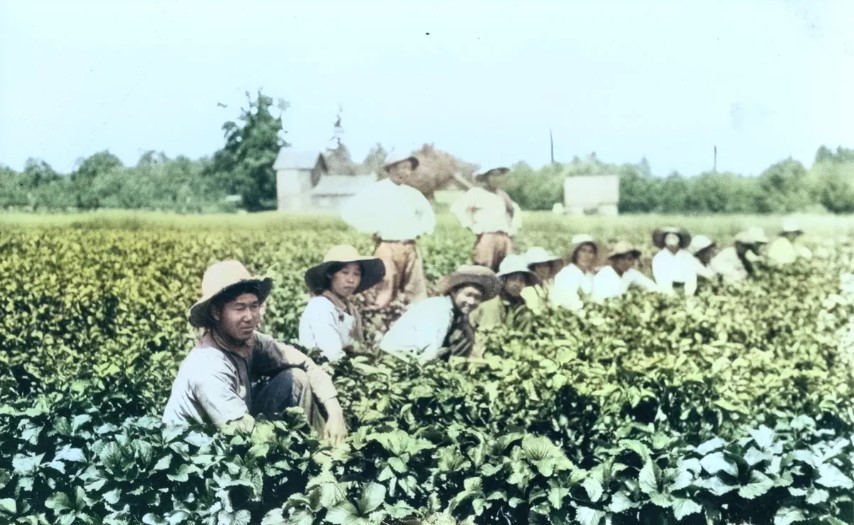
The Japanese Canadian community contributed to the development of the community resources and created the berry industry. In 1927, the Surrey Berry Co-op Hall was built on a parcel of Gentaro Ujiye’s land at the corner of Sandell Road (128 Street) and Townline Road (96 Avenue). Farmers from the Surrey Berry Growers’ Co-operative Association and the Strawberry Hill Japanese Farmers’ Association would meet and conduct business at the hall. The hall would also be used for social events and held the Surrey’s Japanese Language School which was established in 1930. The Japanese Canadian community also financially contributed to the building of Townline Road (96 Avenue).
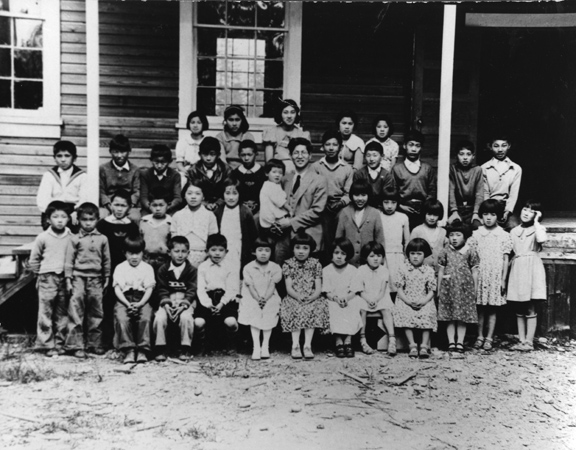
Zennosuke Inouye was part of a group of 222 Japanese Canadians who fought for Canada in the First World War. They were rejected in British Columbia, and this determined group of men travelled to Alberta where they were accepted. The veteran purchased 80 acres of land in 1919. The land was in the Strawberry Hill area, at Sandell Road (128 Street) and south of Townline Road (96 Avenue). The area had recently been logged and he had to clear stumps and undergrowth. He married Hatsuno Morikawa, and their family would grow with five children. Their farm became a success and by 1940 his success included becoming president of the Surrey Berry Growers’ Co-operative Association.
Tsunehachi and Toshie Hoshiko worked their property in Strawberry Hill until 1922 when they purchased 15 acres on Bergstrom Road (King George Boulevard) and Hjorth Road (104 Avenue). They grew strawberries and started a hatchery. Tsunehachi suddenly died of meningitis in 1932 leaving Toshie alone to raise five children. She was a small, but strong woman who kept the farm running until the forced uprooting and dispossession in 1942.
Kanetoshi Morioka came to Canada in 1924 and worked and saved for three years before buying 20 acres of land on Townline Road (96 Avenue) near 134 Street. He used dynamite and horses to clear the land. He planted strawberries. By 1940, he had a successful strawberry farm with a bunkhouse for employees, a hothouse to grow rhubarb, and over 2,000 chickens.
Kamakichi Nagasaka started a family farm in the Strawberry Hill area in 1915. Kenji Okabe came to Canada in 1924 to help on the farm. In 1934 Kenji marries Yoshie Nagasaka and starts his own farm, five acres on Horel Road (near 90 Avenue and 120 Street). He grows strawberries, fruit trees, and raises chickens. They had about 6,000 chickens before incarceration. Kamakichi’s grandson Roy Nagasaka remembers the family returning to Surrey in 1951. He said his father bought a farm around 88 Avenue and 132 Street in 1953. They farmed the land and had 10,000 chickens.
Takejiro Hirasawa owned 20 acres of land in Strawberry Hill. It was purchased uncleared for $2,000 in 1911. Takejiro invested another $18,000 in improvements in the farm. Takejiro kept meticulous records including a drawing of the farm’s layout. The farm included 6 acres of strawberries, other fruit and vegetables, 60 apple trees, and 2,000 chickens. It was a successful farm with a net income of $6,000 per year in the years before incarceration. As part of the dispossession of Japanese Canadians, the government took the farm without Hirasawa’s permission and sold it for $2,377 in 1943.
Japanese Canadian farmers were in other parts of Surrey including Cloverdale where Japanese workers were established since the late 1800s. Motosaku Akagi was born in 1897 in Cloverdale. His family’s story is not known, but his story includes enlistment in the Canadian Army in 1940 in Canada and England. He received awards, the Canadian Volunteer Service Medal with Clasp and the Defence Medal.
Mikizo Nishiguchi came to Canada in 1900 and became a successful owner of a general store, barbershop, tobacco shop and pool hall in New Westminster. In 1920, his businesses were being taken care of by family members, so he started a new venture in Cloverdale where he purchased 60 acres of land. He cleared the land and planted strawberries, fruit orchards, and raised pigs. He built rows of bunkhouses for his workers.
Hitoshi and Mikiye Shigeta started in farming. They owned five acres of land near 58 Avenue and Bergstrom Road (King George Boulevard) and after raising a family, they opened the Pioneer Trading Store in 1934. The general store sold groceries, produce, hardware, tools, clothing and drugstore items. Around 1937/1938, they added a gas station.
In 1942, the government used racial discrimination and fear mongering to forcibly uproot 22,000 Japanese Canadians from the west coast including over 500 from Surrey. They would be dispossessed, incarcerated, and exiled until 1949, four years after the war ended in 1945. The Canadian military and RCMP told the government there was no need to take any action against the Japanese Canadians, but the government refused to listen.
On March 11, 1942, The Surrey Leader newspaper reported about the fate of the chickens and the strawberry crops.
“Flocks totalling approximately 150,000 laying hens will be liquidated by the evacuation of the Japanese from the Fraser Valley during the next few weeks, it is estimated. Thousands of birds have been marketed daily during the past two weeks. From the Scott Road – Strawberry Hill district of Surrey along close to 100,000 birds will be sent to market. Even in worse predicament are Surrey growers of strawberries which is one of the largest cash crops raised here. In former years as many as 200 Japanese pickers have been employed on one large Japanese strawberry farm. Just what will happen to this crop is not clear, as without constant cultivation strawberry beds soon run wild.”
The Morioka family were uprooted and separated for six months. Kanetoshi Morioka was sent to a road camp in Blue River. His wife Natsuki and three children were sent to a camp in the Slocan area. In 1949, he saw an ad for 10 acres of land in Surrey. He bought the land near Kennedy Road (88 Avenue) and 150 Street and was the first Japanese Canadian family to return to Surrey after the incarceration ended in 1949.
Zennosuke Inouye wrote over 80 letters during incarceration to protest the taking of his land. He reached out to elected officials and various contacts and advised them of his service to Canada during the First World War when he fought at Vimy Ridge and was wounded. He appealed to Justice Henry Bird (also a First World War veteran) who oversaw the Royal Commission looking at the forced sale of Japanese Canadian property. The connections paid off, and he was the only Japanese Canadian to have his land returned to him in 1949.
Resources
Who was Who: Pioneer Japanese Families in Delta and Surrey by Michael Hoshiko, 1998
Surrey Japanese Canadian Network bit.ly/jcsurrey lorene.oikawa@gmail.com
Thanks to Tami Hirasawa, Roy Nagasaka, Kevin Okabe, and Christine Kondo.

